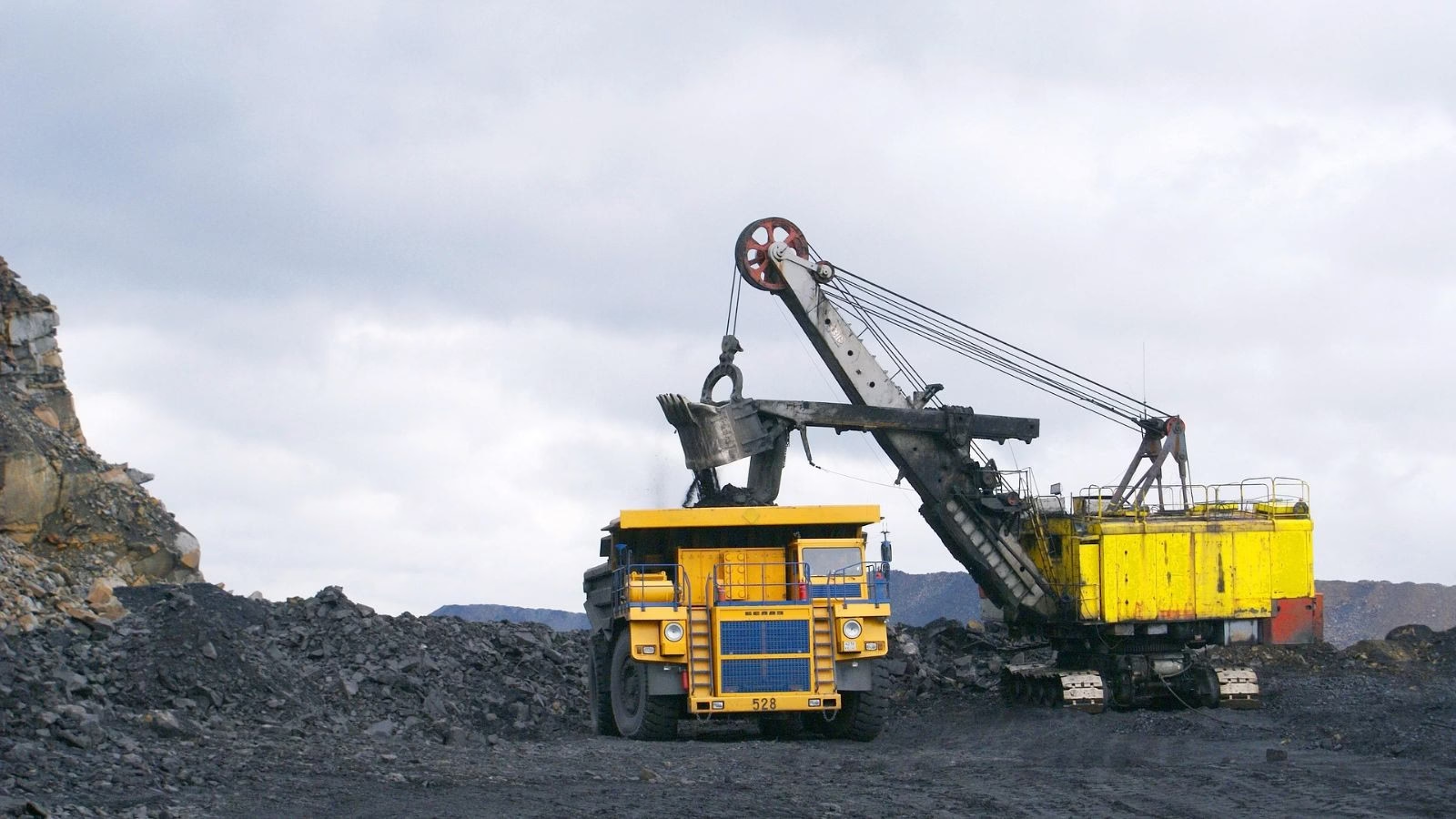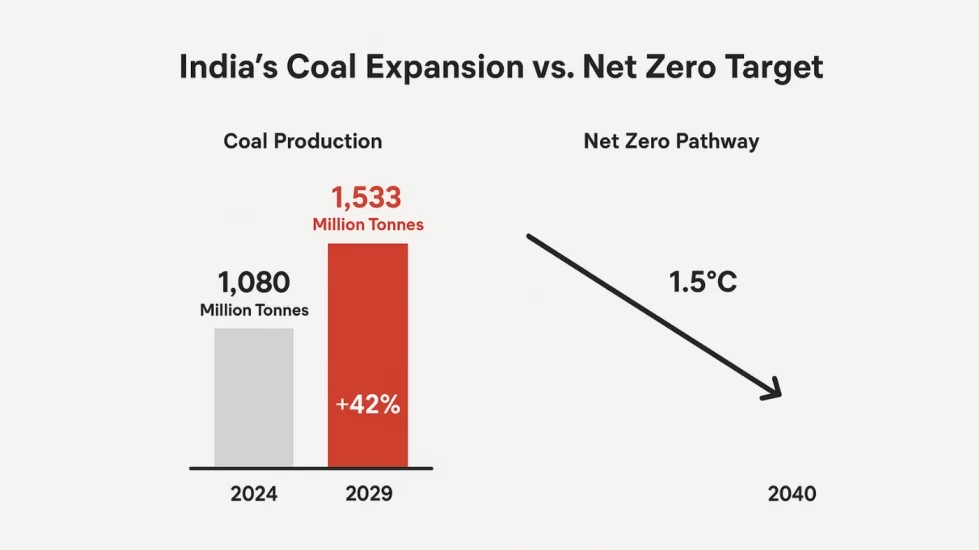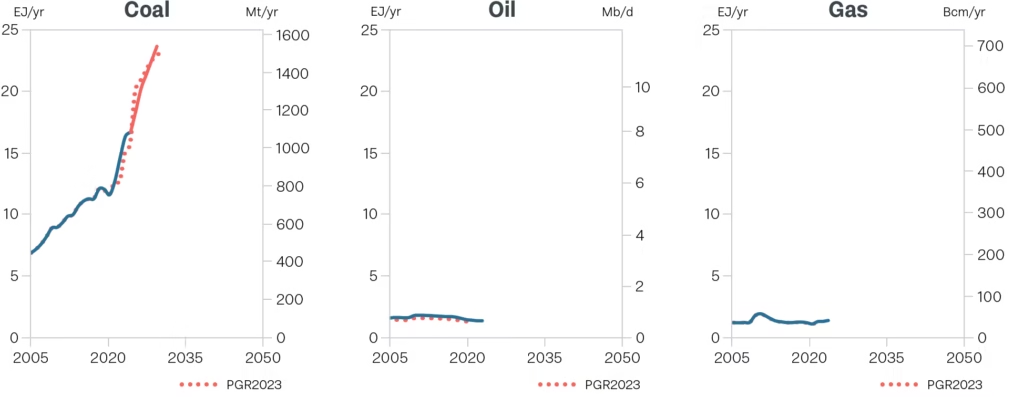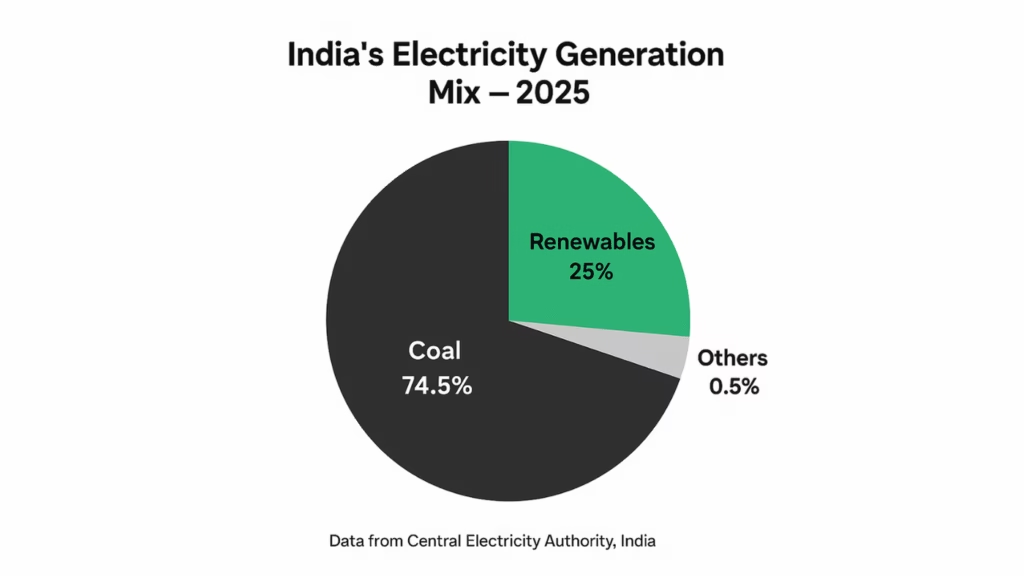Earth
India’s Net Zero at Risk: ‘Production Gap Report’ Flags Coal Surge as Climate Betrayal
India’s coal expansion plan clashes with its 2070 net zero pledge, warns the 2025 Production Gap Report, raising risks of stranded assets and climate fallout.

India today sits at the heart of the global climate debate. With more than 1.4 billion citizens and surging energy demand, it is both a vital growth engine and a critical player in the global clean-energy transition. The government has legally enshrined a commitment to reach net zero emissions by 2070, a pledge at the COP26 climate summit in Glasgow, in 2021, and welcomed as a landmark step. Yet the newly released Production Gap Report 2025 underscores a troubling contradiction: India is simultaneously planning a sharp increase in coal production, a trajectory that risks undermining its own climate promises and the world’s fight to limit warming to 1.5°C.
According to the report, New Delhi aims to raise annual coal output to 1,533 million tonnes by 2029—an increase of 42% over 2024 levels. This expansion comes even as scientists stress that global coal use must peak and begin declining rapidly this decade, with near-total phase-out by 2040, to meet Paris Agreement goals. The report puts it bluntly: “Every year of delay will only increase the challenges and costs of future decarbonization.”

Energy Security vs. Climate Action
Why, then, is coal still central to India’s strategy? Policymakers argue that coal remains indispensable for three intertwined reasons: economic growth, affordable power for millions still climbing the development ladder, and jobs in coal-rich states like Odisha, Jharkhand, and Chhattisgarh. Coal still supplies about 55% of India’s total primary energy, and fuels nearly three-quarters of electricity generation. The government’s Revised SHAKTI (Scheme for Harnessing and Allocating Koyla (Coal) Transparently in India) Policy (2025), unveiled in July, reinforces this trajectory by making coal allocation more transparent and competitive, aimed at “promoting affordable power and seamless thermal capacity addition for economic growth,” as the Coal Ministry put it.

For many within India’s policy establishment, this is not a choice but a necessity. With energy demand projected to double by 2040, and global oil and gas markets increasingly volatile, domestic coal offers a sense of energy sovereignty. Stockpiles at power plants recently touched record highs, enough for 25 days of consumption, a buffer the government celebrated as proof of its robust energy security planning.
The Costs of Persistence
But the other side of the ledger is stark. The Production Gap Report warns that India’s continued coal expansion is fundamentally misaligned with climate science. Global Energy Monitor estimates that many existing coal mines already run below capacity, at only around 64% utilization. Opening new mines risks locking the country into a fossil-fuel path that could soon become economically unviable as renewable energy grows cheaper and more scalable. Analysts caution that billions of dollars in new coal investments could become stranded assets within two decades.
The social costs are equally significant. Tribal and rural communities in mining belts face displacement, loss of livelihoods, and worsening air and water quality. Without a robust “just transition” plan, the burden of India’s coal reliance may fall disproportionately on its most vulnerable citizens.
A Parallel Green Surge
Yet India is also writing another story—one of remarkable clean-energy progress. Over the past decade, solar capacity has expanded nearly forty-fold. Wind, bio-energy, and small hydro continue to grow, supported by policies such as the PM Surya Ghar Yojana and PM Kusum Yojana, which subsidize rooftop solar and farmer-oriented renewable projects. In 2025, the government slashed the GST (Goods and Services Tax) on renewable energy equipment from 12% to 5%, a move projected to save developers $16.9 billion (INR 1.5 lakh crore) by 2030, lowering tariffs and making clean power more accessible.
The numbers reflect this momentum. In the first half of 2025, India’s renewable power generation rose by nearly 25% year-on-year, while the share of fossil fuel-based electricity slipped to below 78%—its lowest in recent years. The Ministry of New and Renewable Energy projects 248 GW of new non-fossil capacity over the next five years, putting the country on track toward its ambitious 500 GW clean-power target by 2030.

A Decisive Decade
The contradiction is clear: India is simultaneously expanding its coal base and accelerating into the clean-energy future. This dual track reflects the country’s developmental realities, but it also sharpens the urgency of the choices ahead. Without clear timelines for peaking and phasing down coal, the net zero pledge of 2070 risks looking increasingly fragile.
The answer, experts argue, lies not in choosing coal or clean energy in isolation, but in crafting a comprehensive strategy: ensuring coal-dependent states receive support for economic diversification, investing in grid modernization and storage to handle more renewables, and phasing out inefficient coal plants while stopping new approvals. Done right, India could avoid both the trap of stranded assets and the perils of climate inaction.
As the Production Gap Report 2025 makes clear, the coming decade will be decisive. For India, the crossroads is stark: persist with a coal-heavy pathway that offers near-term comfort but long-term risk, or accelerate a transition that secures both its development aspirations and its place as a climate leader. The world is watching closely, but more importantly, India’s own future prosperity may hinge on the choices it makes today.
Earth
Data Becomes the New Oil: IEA Says AI Boom Driving Global Power Demand
Global energy systems enter a new phase as electricity demand surges from data centres and AI, prompting the IEA to warn of mounting risks across fuels, minerals, and grids in its World Energy Outlook 2025.

The world is facing a more complex and fragile energy security landscape than ever before, according to the World Energy Outlook (WEO) 2025 released by the International Energy Agency (IEA) on Wednesday. The report calls for greater diversification of energy supplies and stronger international cooperation to navigate a period marked by overlapping risks across fuels, technologies, and supply chains.
The IEA notes that energy security tensions now span oil, gas, critical minerals, and electricity systems simultaneously — a situation without precedent in recent decades. “There is no other time when energy security tensions have applied to so many fuels and technologies at once,” said Fatih Birol, Executive Director of the IEA, in a statement. “Governments must show the same focus that they did after the 1973 oil shock.”
Emerging economies drive new demand
The WEO 2025 highlights a major shift in global energy demand patterns. India and Southeast Asia, along with countries in the Middle East, Africa, and Latin America, are emerging as the main drivers of future energy consumption. Collectively, these regions are expected to replace China — which accounted for 50% of oil and gas demand growth and 60% of electricity demand growth since 2010 — as the primary forces shaping global energy markets.
Data centres, AI surge push electricity demand
Electricity remains at the core of modern economies, with consumption projected to grow faster than total energy use across all scenarios. Investments in electricity generation have surged by nearly 70% since 2015, yet spending on power grids has increased at less than half that rate — creating potential bottlenecks.
The IEA notes that global electricity investment already equals half of total energy spending. Demand from data centres and artificial intelligence is now rising rapidly even in advanced economies. The report estimates that global data centre investment will reach USD 580 billion in 2025, surpassing the USD 540 billion being spent on oil supply — a striking indicator of how digitalisation is reshaping energy priorities.
Critical mineral dependency intensifies
The report warns of growing vulnerabilities in critical mineral supply chains, with one country dominating refining for 19 of 20 key strategic minerals, averaging a 70% global market share. These materials are crucial not only for clean energy technologies such as batteries and electric vehicles but also for defence, aerospace, and AI hardware.
Geographic concentration in refining has increased for nearly all major energy minerals since 2020, particularly for nickel and cobalt, making diversification a strategic priority for energy security.
Fossil fuel outlook and LNG expansion
The WEO 2025 finds ample global oil and gas supplies in the near term, with oil prices stabilising around USD 60–65 per barrel. A wave of liquefied natural gas (LNG) projects is also reshaping gas markets, with 300 billion cubic metres of new annual capacity expected by 2030 — a 50% increase over current levels. About half of this new capacity is being developed in the United States, and another 20% in Qatar.
Despite short-term supply stability, the IEA cautions that both oil and gas markets remain exposed to geopolitical shocks and volatile demand.
Climate goals off track
The report delivers a sobering message on global climate progress: no scenario keeps global warming below 1.5°C this century without drastic emissions cuts. While the pathway to net zero by 2050 could eventually bring temperatures back below that level, the world is already overshooting near-term targets.
About 730 million people still lack access to electricity, and two billion depend on unsafe cooking fuels. A new IEA scenario outlines universal electricity access by 2035 and clean cooking by 2040, driven largely by liquid petroleum gas (LPG) and renewable options.
A new era of electricity and resilience
The IEA describes the current moment as the “Age of Electricity,” where electric power underpins over 40% of global economic activity but still represents only 20% of final energy use. The report stresses that expanding grids, storage, and renewable capacity must accelerate to meet both climate and economic goals.
“Breakneck demand growth from data centres and AI is helping drive up electricity use in advanced economies,” said Dr Birol. “Those who say that ‘data is the new oil’ will note that investment in data infrastructure now exceeds spending on global oil supply — a striking example of the changing nature of modern economies.”
COP30
Over 832,000 Lives Lost, $4.5 Trillion in Damages, Extreme Weather The “New Normal”: Warns Climate Risk Index
A new report reveals the staggering toll of extreme weather — over 832,000 deaths and $4.5 trillion in losses between 1995 and 2024.

The numbers are stark, and the story they tell is even starker. More than 832,000 people have lost their lives and USD 4.5 trillion in direct economic losses have been recorded worldwide as a result of nearly 9,700 extreme weather events over the past three decades. That is the central finding of the Climate Risk Index (CRI) 2026, released by the environmental think tank Germanwatch at COP30 in Belém, Brazil.
The new report — the most comprehensive edition of the CRI to date — presents what its authors describe as a “mirror to global injustice”: a world where the poorest nations, least responsible for greenhouse gas emissions, continue to suffer the greatest losses.
Global South at the epicentre
According to the analysis, around 40% of the world’s population — more than three billion people — live in the eleven countries most affected by extreme weather events since 1995. These include India (ranked 9th), China (11th), Haiti (5th), and the Philippines (7th) — all nations of the Global South. None of these countries belong to the world’s richest economies, yet they bear the heaviest brunt of climate shocks.
“Heat waves and storms pose the greatest threat to human life when it comes to extreme weather events,” said Laura Schäfer, one of the index’s lead authors, in a statement. “Storms also caused by far the greatest monetary damage, while floods were responsible for the greatest number of people affected.”
In the 30-year period covered, storms alone caused over USD 2.64 trillion in damages, while floods accounted for nearly half of all people affected by disasters. Floods, storms, heat waves, and droughts together formed the deadly quartet responsible for most of the losses — both human and economic.
A decade of unrelenting disasters
From hurricanes that erased Caribbean islands to floods that swept away entire cities, the CRI 2026 paints a grim global mosaic.
At the top of the long-term index is Dominica, a tiny Caribbean island nation that has faced multiple catastrophic hurricanes. In 2017, Hurricane Maria alone caused losses amounting to three times the country’s GDP.
Myanmar ranks second, largely due to Cyclone Nargis (2008), which killed nearly 140,000 people and left deep scars still visible today. Honduras, Libya, Haiti, and Grenada follow, all of which endured either singularly devastating or repeated disasters.
The report notes that countries like Haiti, the Philippines, and India are trapped in cycles of destruction and recovery. “They are hit by floods, heat waves, or storms so regularly that entire regions can hardly recover from one disaster before the next strikes,” explained Vera Künzel, co-author of the index.
India among the top ten
India’s inclusion in the top ten highlights the scale and variety of climate hazards the country faces. Between 1995 and 2024, India endured over 430 major extreme weather events, resulting in more than 80,000 deaths, affecting 1.3 billion people, and inflicting USD 170 billion in damages (inflation-adjusted).
Recurring heat waves, increasingly intense monsoons, and devastating cyclones — from Odisha (1999) to Amphan (2020) — have made India one of the world’s most climate-vulnerable economies. Urban flooding in states like Maharashtra and Gujarat, and glacier-related floods in the Himalayas, have further underscored this fragility.
Even the rich are not spared
While the Global South remains most exposed, the new index shows that climate risks are no longer confined by wealth or borders. The United States (ranked 18th) and European nations such as France (12th) and Italy (16th) appear among the top 30 most affected countries — a reminder that the climate crisis has become universal.
“COP30 must find effective ways to close the global ambition gap”
The authors warn that no country is immune from the accelerating impacts of global warming. The year 2024 was the hottest on record, with global temperatures surpassing 1.5°C above pre-industrial levels for the first time. Scientists estimate that human-caused climate change added 41 extra days of dangerous heat for billions of people last year alone.
“The CRI 2026 results clearly demonstrate that COP30 must find effective ways to close the global ambition gap,” said David Eckstein, another co-author. “Global emissions have to be reduced immediately; otherwise, there is a risk of a rising number of deaths and economic disaster worldwide.”
A call for climate justice
The report urges the world’s wealthier nations to deliver on their long-standing promises of climate finance and loss-and-damage support for developing countries. Despite repeated commitments, funding for adaptation and disaster recovery remains far short of what vulnerable nations need.
Germanwatch estimates that developing countries may require up to USD 1.7 trillion annually by 2050 to address loss and damage caused by climate impacts. Without this support, the gap between rich and poor in climate resilience will only widen.
The CRI 2026 also points to positive developments — notably, a recent International Court of Justice advisory opinion affirming states’ legal duty to prevent and address climate harm, including through finance and reparations. The ruling, the authors note, adds legal and moral weight to the demands for urgent global action.
A warning — and a choice
Ultimately, the report is more than a statistical document; it is a warning. The patterns of destruction it reveals — from hurricanes in the Caribbean to heat waves in Asia — are not anomalies but signs of a “new normal.”
As COP30 negotiators gather in Belém, the message from the data is clear: unless emissions fall sharply and adaptation accelerates, the toll in both human lives and economic costs will keep rising.
“In a warmer world, tropical cyclones are becoming more intense and more destructive,” said Lina Adil, co-author of the index. “Without sustained global support, some nations will face challenges that are simply insurmountable.”
COP30
Brazil Cuts Emissions by 17% in 2024—Biggest Drop in 16 Years, Yet Paris Target Out of Reach
Brazil’s 2024 emissions dropped 16.7% to 2.15 GtCO₂e, led by Amazon deforestation control—the biggest annual fall since 2009—but the country still risks missing its Paris climate goals.

Brazil’s groEmissionsss greenhouse gas emissions fell from 2.576 billion tons of CO₂ equivalent in 2023 to 2.145 billion tons in 2024, the lowest drop since the country’s 17.2% decline in 2009. This turnaround was powered by enforcement against illegal deforestation, reversing a period of lax protections between 2019 and 2022. The net emissions figure—which deducts carbon absorbed by secondary forests and protected areas—dropped even further, down 22% year-on-year, landing at 1.489 billion tons in 2024.
Sectoral Breakdown: Where Emissions Fell and Rose
The land-use sector, mostly deforestation, saw its gross emissions tumble from 1.341 to 0.906 billion tons (32.5% drop)—the largest reduction on record for any sector. This shifted the national emissions profile:
>> Land use change: 42% in 2024, compared to 52% in 2023
>> Agriculture: 29%, up from 24%
>> Energy: 20%, up from 16%
>> Waste: 5%
>> Industrial processes: 4% (both stable)
Emissions in agriculture and energy remained mostly flat, with only waste (up 3.6%) and industry (up 2.8%) recording notable increases.
Deforestation Down, but Not the Whole Story
Enhanced government actions led to a 33% decline in Amazon deforestation emissions and a 41% drop in the Cerrado. Nevertheless, fires not associated with deforestation nearly doubled Brazil’s net deforestation emissions—an emerging risk as climate change fuels extreme drought and wildfires across formerly resilient biomes.
Agriculture, Cattle, and Energy: Stubborn Sources
Brazil’s cattle sector remains the single largest emissions source, responsible for roughly 51% of national total. Efforts to control methane—including increased feedlot use and smaller herds—delivered a marginal 0.2% reduction in herd size and a slight drop in emissions. Nitrous oxide from fertilizers and lime also saw small declines, offsetting overall emission growth. Notably, emissions from energy rose nearly 1% due to record travel and electricity demand; only record ethanol and biodiesel consumption kept fossil CO₂ in check.
Paris Pledge Still Out of Sight
Despite the historic emissions drop, Brazil is projected to end 2025 with net emissions of 1.44 billion tons—9% above its target under the Paris Agreement of 1.32 billion tons. While deforestation is falling, rising emissions from energy, agriculture, waste, and industry threaten to undermine overall climate progress. Experts emphasize that broader emission cuts, especially in fossil energy, are urgently needed for Brazil to have a chance at meeting its 2030 target (1.2 billion tons).
Brazil’s 2024 emissions breakthrough underscores the pivotal impact of deforestation control on the country’s climate footprint. Yet, absent deeper reforms in agriculture, waste, and especially energy, Brazil’s Paris goals may remain out of reach—a clear signal for policymakers ahead of COP30.
-

 Space & Physics6 months ago
Space & Physics6 months agoIs Time Travel Possible? Exploring the Science Behind the Concept
-

 Know The Scientist6 months ago
Know The Scientist6 months agoNarlikar – the rare Indian scientist who penned short stories
-

 Know The Scientist5 months ago
Know The Scientist5 months agoRemembering S.N. Bose, the underrated maestro in quantum physics
-

 Space & Physics3 months ago
Space & Physics3 months agoJoint NASA-ISRO radar satellite is the most powerful built to date
-

 Society5 months ago
Society5 months agoAxiom-4 will see an Indian astronaut depart for outer space after 41 years
-

 Society5 months ago
Society5 months agoShukla is now India’s first astronaut in decades to visit outer space
-

 Society5 months ago
Society5 months agoWhy the Arts Matter As Much As Science or Math
-

 Earth5 months ago
Earth5 months agoWorld Environment Day 2025: “Beating plastic pollution”



































